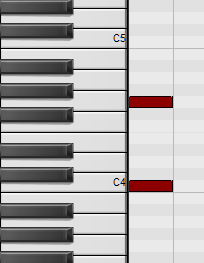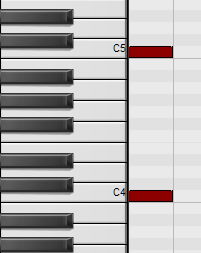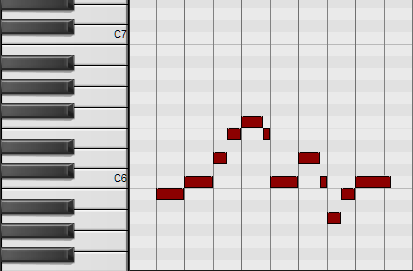Dungeon Synth Composition 101
Note: this is from the perspective of someone using a DAW (digital audio workstation) on their computer. I (AvelineBaudelaire aka Wooden Vessels) use Reaper so it will be from that point of view, but most DAWs should be able to do all of these things.
A list of common DAWs & VSTs (virtual studio technology aka software instruments & effects) can be found on the Gear page.
Here’s the quickest of quick start guides:
- download a couple VSTs
- open up your DAW
- load your VSTs into the DAW (might be tricky if you’re new to DAWs - here’s a guide for Reaper)
- create a new software instrument track (in Reaper Right-Click in the left panel & select ‘Insert virtual instrument on new track’)
- assign the new track a VST
- use your mouse to make a Piano Roll region in the ‘playback zone’ of the DAW for this track (in Reaper hold Ctrl+Left-Click and drag)
- double click on that region to open the Piano Roll editor
-
put some notes in and hit Play to hear what it sounds like
- double clicking or click & dragging are pretty common ways to ‘paint in’ a note
- clicking & holding near the right edge of the note allows you to change the length/duration of the note in most editors
- clicking & holding in the middle of the note allows you to change which beat it plays on
- repeat all these steps for to make new tracks, VST sounds, and songs sections (with Piano Roll regions) until you’re happy with your song
- Export or Render the song as an mp3 or wav file & toss it on Bandcamp or Youtube (or wait until you have an EP or album worth of songs)
- congrats on your Dungeon Synth first song 🎉
A more in-depth guide following how I make music:
First I do some planning and outlining. I ask myself questions like these:
- what aesthetic, vibe, or sub-genre am I aiming for?
- will there be a story tying everything together or will each song be its own story?
- what is the setting of the story (or stories)?
- what instruments and sounds make sense for that setting?
- do I want to keep things pretty mild or do I want to get wild?
- how long should the album be?
- given the length, how many songs should I aim for?
Once I have fairly solid answers to these questions I start swapping between making short musical ideas, working on the story (or stories), and start on the album art (or seek someone out to handle that part). I’m going to keep this much more focused on the music making piece of this. If you’re curious about how I approach writing the stories or making the album art feel free to send me a message. That said, I cannot stress enough how important the story/mood/atmosphere part is to the creative process. It is vital and truly drives creative inspiration. I highly recommend creating an environment that works for you - candles, incense, inspiring posters, moodboards, reading a book or listening to music beforehand, dimming the lights or turning them off completely, putting some swords up on the wall, changing into a ‘ritual’ outfit, spending a week running with the foxes or wolves in the woods, communing with faeries & gnomes near the magic creek, staring longingly into a goblin’s eyes for 30 minutes, whatever works best for you. It helps so much.
I have two basic methods that I use a lot when making music: hooking up a MIDI keyboard and playing around until I find something I like, and playing around in the Piano Roll until I find something that sounds decent. Sometimes the underlying chords come first. Sometimes the melody comes first. Sometimes I Most of the ideas made at this point don’t make it into the song or the album. Not every idea is a keeper, but I’m a firm believer that making these ‘bad’ or ‘okay-ish’ ideas helps get the brain into Creative Mode™. Sometimes it takes a loooong time to get there - weeks even. And other times it happens almost instantly. Pro tip: playing only white keys will almost always sound good and ‘in key’
Some ‘chords’ (or perhaps more accurately ‘intervals’) I like to play around with are fourths, fifths, and octaves. These are generally pretty strong sounding, and have been used in all sorts of music for centuries. If you’re totally new to music making, scales, and whatnot here’s how to find these notes. Start on any white key. Play that note. Counting white keys to the right of that note: 1 is the note you’re playing, 2 is the next white key, then 3, then 4. Play the 4th white key. That’s a fourth. A fifth is the same idea - count to 5 on the white keys to the right. Make sure to count the key you’re playing as 1. An octave (as in 8) is the exact same note that you’re playing, but in the next ‘register’. You can find it by counting to 8, making sure to count the note you’re playing as 1.



I feel like melodies are one of my weak points, and I’ve been trying to work on crafting them. One basic formula I’ve found to be useful is to pick a low note and a high note no more than about 12 notes apart. This is the range the melody will stay inside of. Then try to make the melody have a rise and fall. The high note should only be hit one time. Same for the low note. Remember, this is just a thing I’ve been trying out. It’s not the best or only way to build a melody.
After there’s a good foundation for either a melody or a chord progression (which is a series of chords) I loop it and make some options for the other part. Usually this is all done with just one track and one VST. More sounds can be added later, and with a DAW it’s quick & easy to see what the idea I’m making sounds like with another VST or instrument. I try to make at least 3 or 4 different ‘options’ to go with the part that’s looping. Again, this doesn’t have to be groundbreaking music. It’s mostly to get some rough ideas out there. Many of them probably won’t even be used in the final product.

When there’s a few ideas I’m satisfied with I see if any fit together. Maybe they’ll each be in their own songs, but maybe some of them sound great together. This is the part where I start planning out the structures for the first few songs. Maybe song 1 will have Part A, then Part B, then Part A again (ABAB). Maybe song 2 will have a verse/chorus type of thing like ABACB. Maybe song 3 will just be Part A, but stuff will slowly get layered in on top of it. Some songs will have extended intros or outros. The combinations are unlimited: ABCABC, ABBACC, ABACDDC, you get the idea. If you’re new to making music aim for a simple one like ABAB, ABAC, or ABCBC. Complicating things too much can be discouraging and ruin an otherwise good song.
Also keep in mind that none of these decisions have to be final. My songs go through so many iterations. You never know when you’ll stumble across the perfect thing to add in. This is the stage where I start experimenting with adding more tracks/VSTs/instruments into the mix.
I continue this workflow until I have a solid foundation to about half the songs for the album. Then I start fine-tuning things a bit more. I’ll make the transitions smooth and add some melodic variations to keep the music from becoming stale. By ‘smooth transitions’ I’m referring to the place where Part A becomes Part B, etc. Oftentimes the notes that lead into the next section will have to be altered a bit to keep the transition from being too jarring. Sometimes I add some quicker notes that head towards the starting notes of the next section. Sometimes I have lower chords fade in for a few beats before the next section starts. Stuff like that.
Finally, I add the bells & whistles to the songs. Once most of the songs are feeling good I add all the extra stuff in: underlying drones, background flourishes, little sound effects at impactful parts, field recordings, other background textures. Dungeon Synth is all about atmosphere, and these are the things that can turn a good song into a great song. In fact, sometimes I start with the background textures and drones. Don’t go overboard though. There’s a delicate balance point where things go from atmospheric & meaningful to overused & annoying. Less is more.
And there you have it! The album is finished. Again, this is just the general approach that I take. I don’t follow this exact pattern for every song I make. Experiment and see what works best for you. Adventure awaits!
Some general creative tips:
- limitations can be excellent - using only 5 instruments/tracks, capping the number of effects at 3, only using presets, only using sounds you crafted yourself, etc. can help build up your creative & innovation skills.
- deadlines can aid in creativity - not for everyone, but I find that having a ‘due date’ for my album makes me more likely to work on it rather than starting a new album, and another new album, etc.
- focus on ‘good enough’ rather than perfection - there’s value in having a high quality song, but there’s also value in knowing when a song is solid enough to be complete...if that makes sense.
- quality over quantity - may seem like the opposite of the previous point, but having 7 quality songs is so much better (and more satisfying!) than having 30 low effort songs.
- focus on the journey rather than the destination - most of us would love to have some level of fame in the scene, but being caught up with checking views/sales/upvotes/purchases/listens/etc will only harm you mentally and make you resent what you do.
- don’t compare yourself to other artists - to the point above, everyone is at a different place in their life and with their music. Set some realistic personal goals and make progress towards them. Don’t base your success on someone else’s life.
- HAVE FUN - this is absolutely the most important thing. If you aren’t having fun you should seriously consider taking a break and coming back to things when you can find joy and wonder in them again. This could be days or it could be months. Creating should be fun <3